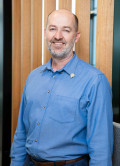
Prof Stuart Pitson
Head of Molecular Signalling Laboratory at Centre for Cancer Biology
Current Positions:
- NRF Chair of Brain Tumour Research - 3 Year Position (2019-2021)
- Head of Molecular Signalling Laboratory, Centre for Cancer Biology, University of South Australia
- Biochemistry Affiliate, School of Biological Sciences, University of Adelaide
Achievements:
- Commercialisation Award at the 2018 UniSA Research Awards
-
NHMRC Senior Research Fellow, Institute of Medical and Veterinary Science (IMVS) (2017-2010)
Research Area:
Professor Pitson leads a team that has made some important discoveries in glioblastoma, including highly promising new drug targets that could suppress the tumour’s growth and block its ability to resist treatment.
Highly invasive and difficult to treat, glioblastoma kills more adults than any other brain tumour and takes more young lives than any other disease. Gains for these patients from new treatment efforts remains stubbornly low in comparison to other cancers – with little change over the past 30 years.
Current NRF Funded Projects:
Establishing advanced pre-clinical models for the assessment of potential new therapies for the treatment of one of the most lethal adult brain tumours, glioblastoma
Through the new NRF Chair in Brain Tumour Research at University of South Australia, Adelaide will become the launchpad for a new personalised approach for glioblastoma treatments – the most lethal form of brain cancer. Funded by a $1 million donation from the NeuroSurgical Research Foundation (NRF), the first three year tenure for the Chair will be held by Professor Stuart Pitson, a global leader in brain tumour research. “Our aim for the Chair position is to create a large living glioblastoma biobank that we can use to develop and test new therapies to more effectively treat and ultimately kill the disease.”
“We have developed important relationships with neurosurgeons and glioblastoma patients in order to capture tumour samples for our living biobank and catalogue the different ways the disease is expressed. “We then grow these different types of glioblastoma in the laboratory, and in advanced pre-clinical models we have developed, we can identify what treatments will likely give the best outcome for patients.
“The model we use is by far the best system for pre-clinical evaluation of glioblastoma drugs. And yet, around the world there are very few systems like this that exist to be used in glioblastoma.
As setting up these models is complex and requires considerable resources, Professor Pitson’s lab will become an important hub in Australia for this testing for both research and patient treatment options. The project will help fast-track the translation of research into clinics and give glioblastoma patients a better chance at survival.
Prof Pitson and his team have identified the defect in the glioblastoma cells that appears to cause the cancerous tumour to grow rapidly and become resistant to chemotherapy.
“This single defect, involving hyper-activation of the SK2 protein, is an ideal target for new therapies for glioblastoma. We have developed inhibitor drugs to the SK2 protein which are showing great promise in the laboratory and pre-clinical models. The continued and generous support from NRF will allow my team to enhance our promising research and bring us closer to clinical application. It is essential that we are doing all that we can, and as quickly as we possibly can, to find more effective treatments for glioblastoma so we can increase patient prognosis,” Prof Stuart Pitson.
NRF Funded Research:
Tissue dissociator: The gentleMACS tissue dissociator (Equipment)
Allows for the gentle break-down of brain tumour tissue into individual brain tumour cells, that can then be studied in the laboratory. It allows the isolation and study of brain tumour stem cells, which are only a very minor component of the total tumour mass, but are usually the main reason for tumour regrowth after therapy.
Stereotactic alignment and injection system (Equipment)
This advanced computer-aided stereotactic alignment and injection system enables the accurate implantation of human brain tumour cells directly into the correct tissue environment. These implanted cells form tumours providing the gold standard model for both studying brain tumour biology and assessing new potential therapies. This advanced system will allow us to develop a powerful resource for brain tumour research in SA that will allow the evaluation of our novel anti-tumour agents and provide the ideal system for evaluation of any potential new anti-brain tumour drugs developed in other laboratories around Australia and internationally.
Eppendorf Liquid Handler for glioblastoma research
The Eppendorf Liquid Handler is an automated, high precision liquid dispensing system that will streamline cancer research. The goal is to understand the biology of glioblastoma brain cancer cells in order to find new drugs, and drug combinations, to kill these cells and treat this aggressive disease. This will allow screening of more drugs, and more complex combinations of drugs, and radiation in a shorter period of time, which will make a huge impact on the search for potential new improved therapies for glioblastoma. Funded by Strong Enough To Live.
Glioblastoma Research
Lightsview Ride Like Crazy and the NRF New research will support more effective chemotherapy treatment for one of the most lethal brain cancers, glioblastoma. This funding will allow Prof Stuart Pitson and his team to take his work one step closer to clinical trials. They will examine the molecular mechanisms controlling the growth and survival of cancer cells with the goal of developing new agents to target these mechanisms for anticancer therapy.
Publications:
Neubauer, HA, Tea, MN, Zebol, JR, Gliddon, BL, Stefanidis, C, Moretti, PA, Pitman, MR, Costabile, M, Kular, J, Stringer, BW, Day, BW, Samuel, MS, Bonder, CS, Powell, JA & Pitson, SM (2018). Cytoplasmic dynein regulates the subcellular localization of sphingosine kinase 2 to elicit tumor-suppressive functions in glioblastoma.




